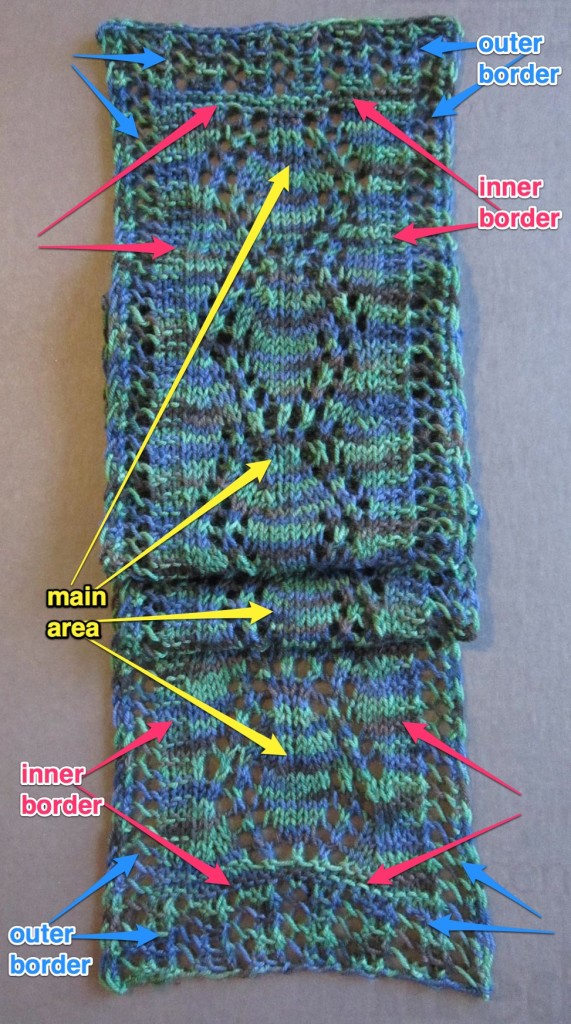Basically, the final rows a one-piece end-to-end scarf with inner and outer borders is a reverse of the beginning. But there are some differences to be noted.
In Overview of Spring Lace Leaves Scarf, I outlined the roadmap for an end-to-end one-piece scarf with knit-as-you-go inner and outer borders. In earlier support articles this month, so far we’ve covered the lower outer border, introducing the inner border, then continuing the established outer and inner borders at each side of the main area lace pattern.
As you approach knitting the full length of your scarf, it will be time to complete the “frame” by finishing your knitting with the upper inner border and finally the ending outer border.
As a reminder, here is the roadmap using Spring Lace Leaves Scarf as our example.
Border at Other End of Scarf
Basically, ending the scarf with inner and outer borders is a reverse of how we began. But there are some slight differences to be noted. These are detailed in your pattern instructions so you don’t have to figure anything out on your own. But I wanted to further explain the design rationale for those who have the interest.
Inner Border Symmetry
It’s not always possible to create exact inner border symmetry around a Main Area lace knitting stitch pattern, but but there are strategies to get close to that look.
For the Spring Lace Leaves Scarf, the pattern directs you to stop one row short of the last full repeat of the Main Area. By omitting the last row of the final repeat, the yarn over holes will be right next to the upper inner border, just like they are at the lower inner border.
One caveat — this design strategy only works when the borders are entirely reversible such as they are for the Herringbone Lace and Garter Stitch of this month’s KAL scarf pattern.
If instead you were to work the final row of the main area Lace Leaf pattern, then there is a row of plain stitches next to the top inner border that is not present next to the lower inner border. This is a very minor detail that certainly would make the scarf no less functional, so don’t fret if you missed seeing this in your pattern instructions.
Re-establishing Stitch Count for Outer Border
For this month’s scarf pattern design, we compensated for a difference in total stitch counts when transitioning from the beginning lower outer border to the inner border by increasing a stitch.
Now reversing that, we decrease a stitch when transitioning from inner border to outer border. Again, the strategy is to “hide” that decrease near the center of the Herringbone Lace row. Thus at completion of this transition row you will again have 30 stitches and be ready to knit the final rows of Herringbone Lace Outer Border.
Organic Non-symmetry
In nature, leaves present themselves growing both upward and downward. So it personally appeals to me that some lace patterns designs like the Spring Lace Leaves Scarf have organic non-symmetry. There is movement and diversity that excites the eye when wearing the scarf.
The “frame” around the main area leaves lends a feeling of symmetry, since we’ve gone to a lot of work to make the inner and outer borders appear the same all around. But that might not be enough for those who prefer static, exact symmetry.
If you prefer exact symmetry to your scarves, I’ll be back soon with an outline of how to alter the Spring Lace Leaves Scarf pattern to a version with matching ends. Watch for “Going Halfsies” coming up next.
p.s. As an extra bonus, I’ll also include the “pull over” bind off join for those who fear grafting or just want to learn an easy no-bulk join.



 HeartStrings FiberArts
HeartStrings FiberArts Knitting Bits of Lace on Facebook
Knitting Bits of Lace on Facebook Ravelry Store
Ravelry Store